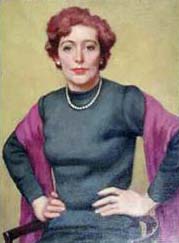Averil Burleigh facts for kids
Averil Mary Burleigh (born Averil Mary Dell, 1883 – 1949) was a British artist. She was known for her paintings, especially those made using egg tempera. Averil Burleigh lived in Sussex and often painted pictures with a main figure in the middle. Her husband and daughter were also artists. However, Averil is considered the most famous of the three.
About Averil Burleigh
Averil Burleigh was born in 1883 in Hassocks, West Sussex. She studied art at the Brighton School of Art. Later, she married another painter, Charles Burleigh. They lived and worked together as artists in Hove and Sussex.
They even designed their own house. It had a big, sunny studio on the top floor. Their daughter, Veronica, was born there in 1909. Veronica also grew up to be a well-known artist. The family did not get rich from their art. Averil often helped them by being good at buying and selling shares in companies.
In 1911, Averil illustrated a book of poems by John Keats. She also illustrated plays by Shakespeare. In 1913, she was featured in Studio magazine. This was a popular art publication. In 1927, Burleigh illustrated Thistledown by Leolyn Louise Everett. From 1939, she was a member of the Royal Watercolour Society.
Averil became very ill in the 1940s. She passed away in 1949. Just before she died, she was made an associate of the Royal Watercolour Society.
Her Art Style
Averil Burleigh mostly painted with tempera. This is a type of paint that uses egg yolk to bind the colors. She also used chalk and watercolors. Her paintings often have bright colors. She used contrasting colors to guide your eye around the picture.
Her tempera and watercolor paintings look very bright. They also have a strong sense of design. Averil often painted decorative scenes from the Renaissance period. These usually featured a female figure. This figure was often modeled after her daughter, Veronica. Averil also painted still life pictures and flowers. Over time, her art style changed. It became freer and less like the Pre-Raphaelite style she started with.
Famous Works
Early in her career, Averil created 24 colorful illustrations. These were for The Poems of John Keats in 1911. Her illustrations had a Pre-Raphaelite style. They often showed a main female figure. For example, in 'Isabella; or, The Pot of Basil', a woman in fancy clothes leans on a pot of basil. Bright pastel colors fill the page. These colors, along with her flowing lines and motifs of birds, butterflies, and flowers, made her watercolors seem like they belonged in a fairy-tale.
However, some people think this view is too simple. For example, Kostas Boyiopoulus described her illustrations for Keats' poem "La Belle Dame sans Merci" as a "nightmare." In these pictures, a "faery's child" changes into a femme fatale (a dangerous woman). The first illustration shows a meeting with a beautiful woman. She has a garland of roses in her hair. The second shows her seated, surrounded by her victims tied to trees. In the first picture, the wind blows her dress and hair. In the second, fallen leaves gather around her, but she is still. Male warriors are shown tied up in trees. They look helpless. The patterns on the woman's dress also made her look very modern for her time.
Burleigh also illustrated plays by Shakespeare. The Chira from the late 1920s is a typical tempera painting by her. It is very decorative. This fits with her Renaissance revival paintings. The model for this painting was probably her daughter, Veronica. The flowers and medieval city in the painting were from Averil's imagination.
The Still Room (1928) is another tempera painting. Averil again used her daughter Veronica as the model. This painting shows how Averil used very rich colors. She also used color to lead the viewer's eye through the painting. In the summer of 1933, this painting was shown at the Royal Academy in London.
Exhibitions
Averil Burleigh showed her art throughout her career. She exhibited at many places. These included the Royal Academy in London. She also showed her work at the Royal Scottish Academy in Edinburgh. Other places included the Society of Women Artists, the New English Art Club, and the Royal Cambrian Academy of Art. She also exhibited with the Sussex Women's Art Club. Her art was shown at the Walker Art Gallery and the Paris Salon.
From 1912 to 1945, she regularly showed her art at the Royal Academy. Between 1930 and 1935, she displayed 17 tempera paintings there. Averil also contributed to the 1913 Arts and Crafts Society exhibition. This event was held at the Grovesnor Galleries.
Images for kids



